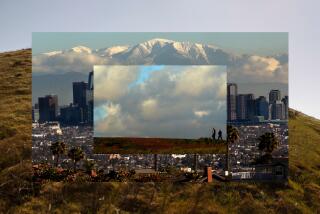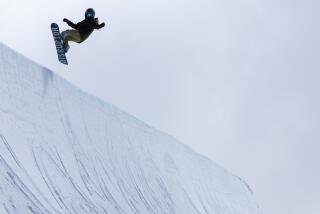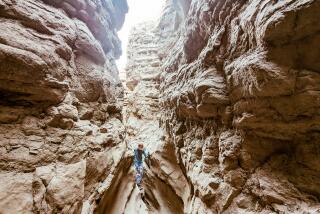At Squaw Valley Alpine Meadows, it’s all about the terrain
Reporting from Olympic Valley, Calif. — At Lake Tahoe’s Squaw Valley Alpine Meadows, it’s not location, location, location, it’s terrain, terrain and more terrain: a combined 6,000 acres of some of the most dependably snowy, scare-yourself-silly inbound skiing and snowboarding among U.S. destination resorts.
Last fall the jointly owned and run resorts announced plans to link the two areas, six miles distant, with a long-imagined (and controversial among local environmentalists) 13,000-foot-long gondola. Skiers and snowboarders now travel between Squaw Valley and Alpine Meadows, which share lift tickets, by shuttle bus.
Linking the two areas would create the largest ski area in California and the second largest in the U.S., behind Utah’s Park City (7,300-plus acres). The resorts hope to have the gondola, which will require approval by local, state and federal authorities, up and running by the 2019-20 season.
My visit to Squaw Valley Alpine Meadows in March coincided with a festive week capped by the women’s World Cup giant slalom and slalom races, both won by U.S. skier Mikaela Shiffrin, the eventual overall women’s World Cup champion last season. (Shiffrin is a multiple gold-medal threat at the 2018 Olympic Winter Games in Pyeongchang, South Korea, beginning Feb. 9.)
I visited in the midst of what would be an epic season of snowfall. Squaw received 728 inches of snow and shut its last lift July 15, its latest closing date ever.
Here’s what I discovered.
Terrain
The two resorts have 14 distinct, easy-to-navigate “mountain zones” defined by ability level, which means skiers and snowboarders can find every variety of ability-confirming or ability-testing terrain they might seek.
Squaw, the site of the 1960 Olympic Winter Games, is known for its cliffs, steeps and extreme (black) expert terrain, all of which has made it a magnet for years for adrenaline junkies, professional free skiers, ski film companies that capture their exploits and weekend (or vacationing) wannabe warriors.
But it also has what may be the Lake Tahoe area’s best beginner terrain, with drop-dead views of the cobalt-blue lake. Although most resorts’ beginner terrain is near the bottom, Squaw’s is fairly high up, segregated from trails frequented by fast skiers and riders, and convenient to the on-mountain High Camp and Gold Coast lodges.
Seventy percent of Squaw’s 170 trails and 16 bowls on 3,600 skiable acres are rated green (beginner) or intermediate (blue), which is surprising given its reputation for extreme terrain.
The resort’s six peaks — Snow King, Broken Arrow, KT-22, Emigrant, Squaw Peak and Granite Chief — offer a 2,850-foot vertical drop and are served by 29 lifts, including a 110-person tram, 28-person funitel (a hybrid tram/gondola), four high-speed six-seaters and three high-speed quads. Combined, they provide a staggering uphill capacity of 53,500 people per hour.
Iconic KT-22 is named for the 22 kick turns Squaw co-founder Wayne Poulsen counted his wife, Sandy, cautiously make on her first descent of the peak; Poulsen opened Squaw in 1949 with East Coast attorney Alex Cushing. KT-22 has been a proving ground for generations of hot-doggers and free skiers and riders, and the starring backdrop of miles of film and gigabytes of digital video.
The peak features the Fingers, a series of tight rock chutes; challenging mogul run Chute 75; Eagle’s Nest, one of the steepest runs in North America; steep tree skiing on Red Dog Ridge; and two runs named for Squaw-bred Olympic gold medalists, Julia’s (Mancuso) Gold and (Jonny) Moseley’s Run.
Intermediates will enjoy a nearly all-blue sector near the Gold Coast lodge and served by the Siberia Express six-seater. For advanced skiers (like me), that chair opens Siberia, one of Squaw’s more open black bowls. The hike-up-to, elevator-shaft chutes of the Palisades are accessible from the top of the Siberia chair.
Another large all-intermediate sector is on the resort’s back side between the Shirley’s and Solitude chairs.
Alpine Meadows offers 2,400 skiable acres on its Ward and Scott peaks, with a 1,802-foot vertical drop. Seventy-five percent of its 100-plus trails and seven bowls (most of them less steep than Squaw’s bowls) are rated intermediate or advanced. Alpine Meadows’ 13 lifts include a high-speed six-seater and two high-speed quads.
Alpine Meadows is noticeably more laid back and less commercial than Squaw, with no shopping or residential development at its base. It impressed me with its long, groomed cruising trails off the Hot Wheels, Yellow, Roundhouse and Kangaroo chairs.
On the back side, more than half of the terrain is rated blue, with the longest runs off the Sherwood chair and shorter choices off the Lakeview chair.
Alpine Meadows’ best expert terrain is higher up on its ridges and in bowls, with access to most of it requiring a high traverse off the Alpine Bowl chair. There are several enormous black bowls on the Pacific Crest back side, South Face and Big Bend among them.
The resorts each average 450 inches of snowfall annually and more than 300 days of cloudless, sunny skies.
Lodging
The purpose-built Village at Squaw Valley, opened in 2005, has a European feel with wood and stone buildings, a handsome plaza and rental units that include standard rooms, studio suites, and one-, two- and three-bedroom suites.
The upscale ski-in, ski-out Resort at Squaw Creek, the area’s most luxurious property, underwent a recent $7 million renovation of its guest rooms. It offers a full-service spa, pool and hot tub complex, shopping promenade, ice skating rink, cross-country skiing, dog-sled rides and horse-drawn sleigh rides.
Private home and condo rentals are available at Alpine Meadows. Lodges and hotels can be found in nearby Truckee and Tahoe City.
Dining/nightlife
The Village offers nearly 60 restaurants, shops, boutiques and bars. Among the best Village restaurants is the Plumpjack Café in the Squaw Valley Inn. Among its most popular, and historic, bars is Le Chamois, a preferred locals’ hangout.
On-mountain options at Squaw include the KT Base Bar, with a large outdoor patio; a ski-up (yes, ski-up) Starbucks; High Camp’s Terrace Restaurant, a sit-down finer lunch option with panoramic lake views; and the indoor/outdoor Mountain Pizzeria at the Resort at Squaw Creek.
At Alpine Meadows, the Ice Bar, at the base of the Sherwood chair, serves grilled bratwurst and beer. The mid-mountain Chalet is a Bavarian-style beer garden offering raclette, pressed sandwiches and draft brews. The Stoked Oak barbecue menu includes tri-tip, regionally produced sausages, pulled pork, ribs, veggie kebabs, cast-iron trout and many sides.
If you go
THE BEST WAY TO SQUAW VALLEY ALPINE MEADOWS, CALIF.
From LAX, American, United and Southwest offer nonstop service to Reno-Tahoe International Airport, and Delta, Southwest and United offer connecting service (change of planes). Restricted round-trip airfares from $266. From the airport it’s a one-hour, 42-mile drive to the resort. The drive from Los Angeles is 496 miles, or about 7 1/2 hours.
WHERE TO STAY
Village at Squaw Valley, 1750 Village East Road, Olympic Valley, Calif.; (866) 818-6963. Doubles from $186 a night.
Resort at Squaw Creek; 400 Squaw Creek Road, Olympic Valley, Calif.; (855) 516-1090. Doubles from $230 a night.
WHERE TO EAT
Six Peaks Grille at Resort at Squaw Creek; (530) 581-6621. Entrees from $24.
TO LEARN MORE
Squaw Valley Alpine Meadows, (800) 403-0206
More to Read
Sign up for The Wild
We’ll help you find the best places to hike, bike and run, as well as the perfect silent spots for meditation and yoga.
You may occasionally receive promotional content from the Los Angeles Times.






